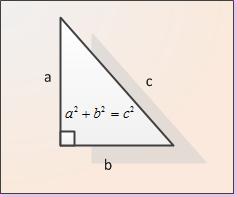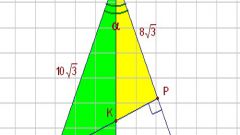Instruction
1
The other two sides are called the sides of a right triangle adjacent to the right angle. In the figure, the legs are designated as AB and BC. Imagine you are given the lengths of both legs. Denote them as |AB| and |BC|. In order to find the length of the hypotenuse |AC|, we will use the Pythagorean theorem. According to this theorem the sum of the squares of the legs equals the square of the hypotenuse, i.e., in the notation of our pattern |AB|^2 + |BC|^2 = |AC|^2. From the formula we find that the length of the hypotenuse AC is as |AC| = √(|AB|^2 + |BC|^2) .
2
Let's consider an example. Imagine you are given the lengths of the legs |AB| = 13, |BC| = 21. By the Pythagorean theorem we see that |AC|^2 = 13^2 + 21^2 = 169 + 441 = 610. In order to obtain the length of the hypotenuse, you must extract the square root of the sum of the squares of the other two sides, i.e., number 610: |AC| = √610. Using the table of squares of integers, it appears that the number 610 is not a complete square of any integer. In order to obtain the final value of the length of the hypotenuse, try to make a full square under the root sign. To do this, divide the number 610 to multipliers. 610 = 2 * 5 * 61. The table of Prime numbers looking 61 is a Prime number. Therefore, further reduction of the number √610 impossible. Get the final answer |AC| = √610.
If the square of the hypotenuse was equal to, for example, is 675, then √675 = √(3 * 25 * 9) = 5 * 3 * √3 = 15 * √3. In the event that such a cast may perform a reverse check - raise the result in the square and compare it to the original value.
If the square of the hypotenuse was equal to, for example, is 675, then √675 = √(3 * 25 * 9) = 5 * 3 * √3 = 15 * √3. In the event that such a cast may perform a reverse check - raise the result in the square and compare it to the original value.
3
Let us known one of the legs and adjacent to it a corner. For definiteness, let it be a leg |AB and angle α. Then we can use the formula for the trigonometric functions cosine the cosine of an angle is equal to the ratio of the adjacent leg to the hypotenuse. I.e., in our notation cos α = |AB| / |AC|. Hence we obtain the length of the hypotenuse |AC| = |AB| / cos α.
If we know the side |BC|, and the angle α, we use the formula for calculating the sine of an angle is the sine of the angle is equal to the ratio of the opposite leg to the hypotenuse: sin α = |BC| / |AC|. We find that the length of the hypotenuse is |AC| = |BC| / cos α.
If we know the side |BC|, and the angle α, we use the formula for calculating the sine of an angle is the sine of the angle is equal to the ratio of the opposite leg to the hypotenuse: sin α = |BC| / |AC|. We find that the length of the hypotenuse is |AC| = |BC| / cos α.
4
For clarity, consider an example. Given the length of the leg |AB| = 15. And the angle α = 60°. Get |AC| = 15 / cos 60° = 15 / 0.5 = 30.
Consider how you can check your result by using the Pythagorean theorem. To do this we need to calculate the length of the second leg |BC|. Using the formula for the tangent of the angle tg α = |BC| / |AC|, we get |BC| = |AB| * tg α = 15 * tg of 60° = 15 * √3. Next apply the Pythagorean theorem, we get 15^2 + (15 * √3)^2 = 30^2 => 225 + 675 = 900. The validation is completed.
Consider how you can check your result by using the Pythagorean theorem. To do this we need to calculate the length of the second leg |BC|. Using the formula for the tangent of the angle tg α = |BC| / |AC|, we get |BC| = |AB| * tg α = 15 * tg of 60° = 15 * √3. Next apply the Pythagorean theorem, we get 15^2 + (15 * √3)^2 = 30^2 => 225 + 675 = 900. The validation is completed.
Useful advice
Calculating the hypotenuse, do the test - whether the value obtained using the Pythagorean theorem.






